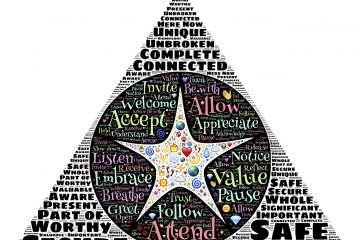
Click below to listen to this article:
Reischer’s six elements of self-transcendence
In the paper, “self-transcendence and life stories of humanistic growth among late-midlife adults” By Reischer et al., (2020), looked at the life stories of individuals in their late-midlife period, and related these to self-transcendence. In the process, the team identified six elements of self-transcendence in life narratives. This article reviews that Reischer’s paper, reviews the six elements, and contrasts some of the findings with contemporary thought.
Background to the paper
The paper aims to address the following aspects of self-transcendence:
- How self-transcendence is related to the life stories of people in late-midlife, who are facing the challenges of ageing, mortality, and generativity.
- What are the narrative themes that characterize the life stories of highly self-transcendent individuals, and how do they differ from those of low self-transcendent individuals?
- How self-transcendence is associated with psychological wellbeing, ego integrity, and humanistic values in late-midlife.
The paper adopts a qualitative and quantitative approach to analyse the life story interviews of 269 Black and White men and women in late-midlife, who also completed self-report measures of self-transcendence. The paper uses grounded theory methodology to identify six narrative themes that form a “humanistic growth story” among highly self-transcendent individuals. These themes are:
Closure: The ability to resolve conflicts and find meaning in negative experiences.
Interconnectedness: The sense of belonging and empathy with others, nature, and the cosmos.
Lifelong learning: The openness to new experiences and perspectives, and the curiosity to explore the unknown.
Secure attachment: The formation of stable and supportive relationships throughout life.
Self-actualization: The pursuit of personal growth and fulfilment of one’s potential.
Spiritual pluralism: The respect for and integration of diverse spiritual beliefs and practices.
The paper contrasts these themes with the life stories of low self-transcendent individuals, who tend to show more fragmentation, isolation, stagnation, insecurity, self-limitation, and spiritual dogmatism.
Benefits of self-transcendence
The paper also discusses the benefits of self-transcendence for late-midlife adults, such as:
Enhancing wellbeing by providing a sense of purpose, coherence, and optimism.
Promoting ego integrity by facilitating acceptance of one’s life and mortality.
Fostering humanistic values by encouraging altruism, compassion, and social justice.
The paper supports its arguments with quotes and examples from the life story interviews, as well as references to previous studies on self-transcendence and related concepts. For instance, the paper quotes a highly self-transcendent woman who said:
“I feel like I’m part of something bigger than myself. I feel connected to people, to animals, to plants, to the earth, to the universe. I feel like there’s a divine plan for everything and everyone, and I’m just a small piece of it.” (Reischer et al., 2020, p. 313)
The paper also cites the work of Erikson (1982), who proposed that self-transcendence is the final stage of psychosocial development in late adulthood, where individuals transcend their personal ego and embrace a broader vision of humanity.
The paper concludes by suggesting that self-transcendence is one possible path of personality growth in late-midlife, that reflects a spiritual journey of humanistic growth. The paper acknowledges the limitations of its sample and methods, and calls for further research on the diversity and complexity of self-transcendence in different contexts and cultures.
The six elements of self-transcendence
Life narratives are the stories that people tell about their lives, which reflect their identity and personality.
The six elements of self-transcendence in life narratives are:
Cosmic connection: the sense of belonging to a larger whole that transcends one’s individual existence. For example, “I feel part of the universe and its mystery”.
Transpersonal connection: the feeling of empathy and compassion for others, especially those who are different or suffering. For example, “I care deeply about the well-being of all living beings”.
Temporal integration: the ability to integrate one’s past, present, and future into a coherent and meaningful whole. For example, “I see my life as a journey that has a purpose and direction”.
Generativity: the desire to contribute to the next generation or to society through one’s work, parenting, mentoring, or volunteering. For example, “I want to leave a positive legacy for the future”.
ego integrity: the acceptance of one’s life as it is, without regrets or bitterness. For example, “I am at peace with myself and my choices”.
Symbolic immortality: the belief that one’s life has significance beyond death, through one’s offspring, creations, or spiritual beliefs. For example, “I believe that my soul will live on after I die”.
Reischer et al. (2020) found that these six elements were more prevalent in the life narratives of people who scored high on self-transcendence measures than those who scored low. They also found that these elements were associated with higher psychological wellbeing and lower depression.
Conceptual contrasts
We can now contrast the paper by Reischer et al. (2020) with some alternate views on the topic.
One such view is that self-transcendence is not a distinct dimension of personality, but rather a facet of openness to experience (Cloninger et al., 1993). According to this view, self-transcendence reflects a tendency to be imaginative, creative, and curious about the world and oneself. However, this view does not account for the existential and spiritual aspects of self-transcendence, such as the sense of connection to a higher power or a larger reality. Moreover, this view does not explain how self-transcendence relates to personality growth and development in late-midlife.
Another view is that self-transcendence is a coping mechanism for dealing with mortality salience (Wong et al., 2016). According to this view, self-transcendence helps people to reduce their fear of death by expanding their sense of self beyond their physical existence and finding meaning and purpose in life. However, this view does not capture the positive and generative aspects of self-transcendence, such as the desire to contribute to the wellbeing of others and the world. Furthermore, this view does not address how self-transcendence influences the construction and reconstruction of one’s life story over time.
The paper by Reischer et al. (2020) offers a novel and comprehensive perspective on self-transcendence and its relation to life stories of humanistic growth among late-midlife adults. The paper shows that highly self-transcendent individuals tend to narrate their lives as spiritual journeys of learning, growth, and transformation. Their stories are characterized by themes of closure (resolving past conflicts and regrets), interconnectedness (feeling connected to others, nature, and the cosmos), lifelong learning (seeking new knowledge and experiences), secure attachment (having supportive relationships), Self-actualization (realizing one’s potential), and spiritual pluralism (embracing diverse beliefs and values). These themes reflect a humanistic orientation toward life that emphasizes personal growth, meaning making, and social contribution.
Delving deeper
The paper also demonstrates the benefits of self-transcendence and its narrative correlates for psychological wellbeing and adjustment in late-midlife. The paper reports that high scores on self-transcendence are associated with higher levels of life satisfaction, happiness, optimism, ego integrity, generativity, wisdom, and post-traumatic growth. Moreover, the paper shows that the six narrative themes of humanistic growth are significant predictors of self-transcendence scores, even after controlling for demographic variables and other personality traits. These findings suggest that self-transcendence and its narrative expression are important factors for achieving optimal functioning and flourishing in late-midlife.
To illustrate these points, we can look at some quotes and examples from the life stories of highly self-transcendent individuals in the paper. For instance, one participant described how he resolved his past conflicts with his father by writing him a letter before he died: “I wrote him a letter telling him I loved him very much … I told him I forgave him for everything he did … I told him I hoped he would forgive me too … He never responded, but I felt a sense of closure” (Reischer et al., 2020, p. 315).
Another participant expressed her sense of interconnectedness with all living beings: “I feel like I’m part of everything … I feel like I’m part of the trees … I feel like I’m part of the animals … I feel like I’m part of the earth … I feel like I’m part of God” (Reischer et al., 2020, p. 316). A third participant exemplified his lifelong learning attitude by pursuing a PhD in his sixties: “I always wanted to go back to school … I always wanted to learn more … I always wanted to challenge myself … I decided to enrol in a doctoral program … It was one of the best decisions of my life” (Reischer et al., 2020, p. 317).
Another participant who scored high on self-transcendence said: “I think I’ve grown spiritually in terms of being more open to other people’s beliefs and not being so judgmental or rigid about what, I think, is right or wrong” (Reischer et al., 2020, p. 316). Another participant said: “I feel like I’m part of something bigger than myself. I feel like I’m connected to nature, to other people, to God” (Reischer et al., 2020, p. 317).
In conclusion, the paper by Reischer et al. (2020) provides a rich and nuanced understanding of self-transcendence and its manifestation in life stories of humanistic growth among late-midlife adults. The paper contributes to the literature on personality development in late-midlife by highlighting the role of self-transcendence as a key dimension of personality growth and well-being. The paper also offers practical implications for enhancing self-transcendence and its narrative expression through interventions such as life review, meaning making, spiritual exploration, and social engagement.
References
Cloninger, C. R., Svrakic, D. M., & Przybeck, T. R. (1993). A psychobiological model of temperament and character. Archives of General Psychiatry, 50(12), 975-990.
Erikson E.H., Erikson J.M., Kivnick H.Q.(1986). Vital involvement in old age: The experience of old age in our time. New York: Norton.
Erikson, E. H. (1982). The life cycle completed: A review. W W Norton & Co.
Levenson, M. R., Jennings, P. A., Aldwin, C. M., & Shiraishi, R. W. (2005). self-transcendence: Conceptualization and measurement. The International Journal of Aging and Human Development, 60(2), 127-143. https://doi.org/10.2190/XRXM-FYRA-7U0X-GRC0
Lifton R.J.(1976). The life of the self: Toward a new psychology. New York: Simon & Schuster.
McAdams, D. P., & McLean, K. C. (2013). Narrative identity. Current Directions in Psychological Science, 22(3), 233-238. https://doi.org/10.1177/0963721413475622
Reischer, H. N., Roth, L. J., Villarreal, J. A., & McAdams, D. P. (2020). self-transcendence and life stories of humanistic growth among late-midlife adults. Journal of Personality, 89(2), 305-324. https://doi.org/10.1111/jopy.12583
Wong, P. T., Reker, G. T., & Gesser, G. (1994). Death Attitude Profile-Revised: A multidimensional measure of attitudes toward death. In R.A Neimeyer (Ed.), Death anxiety handbook: Research instrumentation and application (pp. 121-148). Taylor & Francis.




0 Comments